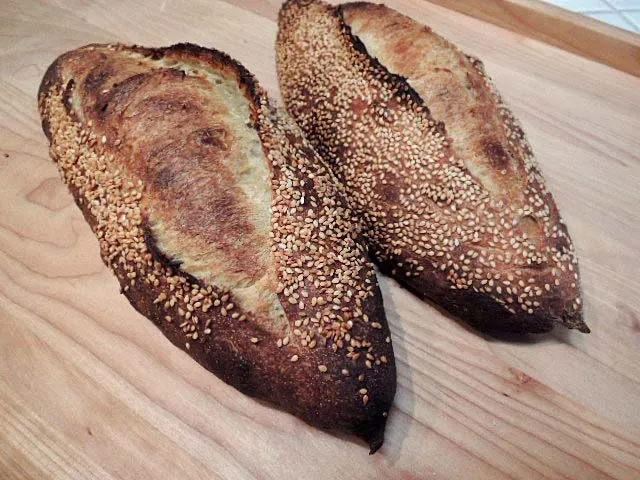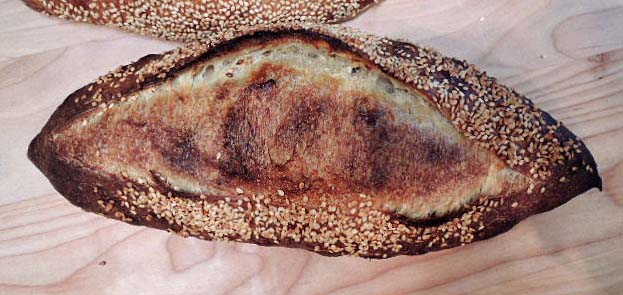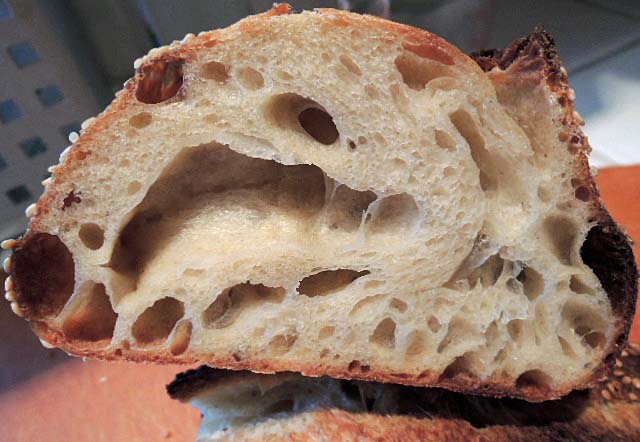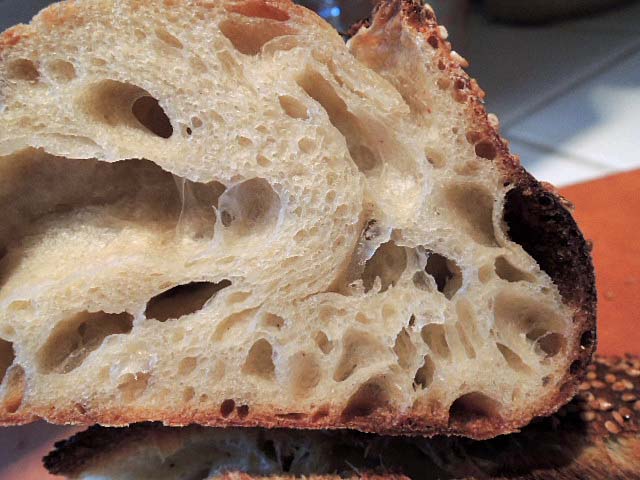
Last week, I got a nice private message from a TFL member who had just made and enjoyed the Sourdough Italian Bread about which I blogged back in 2008. That bread was Peter Reinhart's Italian bread from BBA with the biga converted to a biga naturale, AKA firm sourdough starter.
That message reminded me that in 2011 I developed another “Italian Bread” formula that I actually preferred to the 2008 version. Coincidentally, my Italian class classmates have been harassing encouraging me to bring some of my breads to class for them to sample.
So, I decided to make the 2011 Italian Bread and San Francisco-style Sourdough Bread with Figs and Walnuts (San Francisco-style Sourdough Bread with Walnuts and Figs) to share with my class.
Sourdough Italian Bread
Those who have made my San Joaquin Sourdough may note the resemblance between the method outlined below and that for the SJSD. This is not coincidental. On the other hand, any resemblance between this bread and any bread actually baked in Italy …. Well, whatever, it is quite delicious.
Ingredients | Wt. (g) | Baker's % |
AP flour | 400 | 80 |
Fine durum flour | 100 | 20 |
Water | 350 | 70 |
Salt | 10 | 2 |
Sugar | 14 | 3 |
Diastatic malt powder | 5 | 1 |
Active Liquid levain | 100 | 20 |
Olive oil | 14 | 3 |
Total | 993 | 199 |
Note: When I blogged about this bread in 2011, Andy (ananda) pointed out that the diastatic malt was probably unnecessary, since most American flour has some malted barley already, and it's redundant with the sugar. However, I did not review those comments until after the dough was mixed. Maybe next time I'll leave out the malt.
Method
In a large bowl, disperse the levain in the water.
Add the flours, sugar and malt to the liquid and mix to a shaggy mass.
Cover the bowl and let it rest for 20-60 minutes.
Add the salt and olive oil and mix thoroughly. (Note: I squish the dough with my hands until it comes back together, then do stretch and folds in the bowl until it forms a smooth ball and the oil appears completely incorporated.)
Transfer the dough to a 2 quart lightly oiled bowl, and cover the bowl tightly.
After 30 minutes, do 20 stretch and folds in the bowl. Repeat 3 more times at 30 minute intervals.
Refrigerate for 12-36 hours.
Divide the dough into two equal pieces and pre-shape as rounds or logs. Cover with a clean towel or plasti-crap and let rest for one hour.
Shape as boules or bâtards and proof en couche or in bannetons for about 45 minutes. (Note: Optionally, if proofing en couche, roll the loaves on damp paper towels then in a tray of sesame seeds. Alternatively, you can brush the loaves with water and sprinkle with sesame seeds. If proofing in bannetons, you would use the second method but after transferring the loaves to a peel, just before baking.)
One hour before baking, pre-heat the oven to 480ºF with a baking stone and steaming apparatus in place.
Transfer the loves to the baking stone. Steam the oven, and turn the temperature down to 460ºF.
After 15 minutes, remove the steaming apparatus. (Note: What I actually do at this point is switch to convection bake and turn the oven down to 435ºF for the remainder of the bake.) Continue baking for another 12-15 minutes or until the loaves are nicely browned and the internal temperature is at least 205ºF.
Transfer the loaves to a cooling rack. Cool completely before slicing.



The crust was crisp at first but became soft and chewy after a few hours. The crumb was moist and chewy with a complex sweet, nutty, tangy flavor accented by the sesame seeds on the crust.
This bread is delicious toasted with almond butter or un-toasted dipped in olive oil, but it might be best just plain right after cooling.
Happy baking!
David
- dmsnyder's Blog
- Log in or register to post comments
rhis would be it. That boldly baked crust has to be delicious as well. Just super looking bread inside and out that has to taste great. Very nice David and
happy baking.
It does taste great.
David
Hi David. Not that I am straying away from sourdough. Just wanting to make a few breads this week without the 'waking up' process of my sourdough culture. Any suggestion on how I could make this same formula but without sourdough levain but maybe a poolish/biga? This loaf looks so nice...and bring all kinds of cravings along with it.
John
Well, okay then.
Let's approach this in the simplest way possible. My formula includes 100 g of 100% hydration sourdough starter. That's 50 g of water and 50 g of flour. So, one approach would be to just increase the water and flour in the formula accordingly.
If you follow the procedure with a long cold retardation, the amount of yeast used should be less than usual. I think I would use about 1/4 tsp of instant yeast.
Now, you could certainly make this kind of bread with a biga. However, the cold retardation probably accomplishes the same thing. You could eliminate the cold retardation and use a biga. If you did so, I would use a higher percentage of pre-fermented flour in it to get the benefits. At that point, we pretty much have a different bread.
BTW, if you want to make an Italian-type yeasted bread, if you have BBA, look at Reinhart's Italian Bread formula. You may just want to make that.
Happy baking!
David
I know, I know...I had a feeling I was asking something goofy. I have been desperate in finding a biga/poolish formula that fits my taste and when I saw your loaf I got a bit hasty in asking you of this.
I will still attempt this loaf, but probably with sourdough...as it was meant to be.
Thanks however for the suggestion and beautiful loaf.
John
Outstanding batards, David! your mates must have been blown away. Excellent crust and crumb.
-Khalid
The next class is this coming Tuesday. I'll offer samples of this bread as well as a sourdough walnut-fig bread. Right now, both breads are baked and frozen. I'll thaw them Tuesday morning.
If they are not "blown away," I'll be disappointed (and surprised).
David
Hello David,
Last year I printed off your formula for this bread with my eye on making it, sooner than later. But, being stuck in the heart of Baguette Country, there was quite the pregnant pause getting around to it. That is, until now. In Portland last summer I stopped into a large beer supplies store (you do know that they drink beer in Portland, no?) and it was easy to find diastatic malt powder in a 1 lb. sack for maybe $3. At a local Italian grocery back home I found Caputo Semola Rimacinata, so it was ground extra fine. The ingredients were in place. The only thing missing was the self control to step away from my baguette obsession. Which as you’ll see, I couldn’t quite do!
I’d never baked with olive oil, sugar, semolina, nor malt powder before, so this was a big step outside my world of FWS&Y. And I am pretty good at staying the course with scaling and procedures.
Among the minimal changes I’d made was to create my levain starter from dabrownman’s build schedule, but in a single step. And thereby instantly changing your formula from a SJSD to a "Son of SJSD" as I’d mentioned elsewhere for a different bread. I also increased the formula by 25% to give me the latitude to make 1 600g batard and 2 300g baguettes (surprised, are we?).
As my kitchen is warmer than most, on the 78F-80F side, my bench letter folds were at 25 minute intervals, as well as a 45 minute post-divide warm-up and 30 minute bench proofing, all shorting your recommended timings. And then, and then, and then – whilst in the midst of jockeying dinner in the upper oven with baking in the lower oven, I wasn’t attentive to dropping the temp in the lower oven down to 460F. But not a disaster as the temp. in this new oven drops precipitously before it goes into recovery mode and kicks back in again, thereby creating regular minor migraines in oven temp. management.
I also have sufficient confidence to shape and couche batards and baguettes competently, and to proof them. So what’s the all the ruckus about anyway?
Well, as you can see below, there are exceptions, always exceptions (well, almost always):
Can you shed any light on this?
And, oh, the taste is marvelous, with a roasted aroma and taste to go along with that thick crust. And, as a self-proclaimed expert in the field of toast, I can readily state that it is every bit as good out of the toaster as out of the oven.
Haven’t yet dug into the batard, but I expect the taste to be even deeper and richer.
Any and all advice is appreciated.
Thanks,
alan
PS I’ll be adhering to the normal SJSD build schedule this evening in anticipo of the next bake. Back down to original weight as well.
Hi, alan.
I fail to see any big problems, from your photos.
If your baguette question pertains to the blunt right end seen in the lower left photo, my only thought is a shaping or loading issue. To me, your loaves look good.
A complete review of the comments in this thread will reveal that the malt in the formula is superfluous. To be honest, it was just carried over from another Italian bread formula.
And since you are taking liberties with shaping this bread, I want you to imagine this dough made into submarine/hoagie/grinder/po boy buns and used for sausage-onion-pepper subs or, better yet, meatball subs with homemade marinara sauce and mozzarella.
David
Your words are reassuring. Thank you.
So now, I've searched the world over for diastatic malt powder only to find out after the cow is of the barn that I don't knead it! I made a wrong assumption that since there was no malt in the semolina, and that it is perhaps a different beast that it would neccesitate the oomph from the malt - plus the acquisition of that famously tantalizing deep color that semolina breads often have.
The blunt end, pretty funny, is actually the baguette that has had a few slices lopped off for early, er, scientific experimentation - and for the lower right photo.
I swear, Judge, that the baguettes were shaped correctly as they hit the couche. But when they emerged from the bake, they had a bit of a mind of their own as to what shape to take.
Growing up in NY with a lot of Italian bakeries at arms length, seeded semolinas were omnipresent, and so were the delightful fillings, as you so deliciously describe. But woe be the sap that calls them po boys, subs, grinders, hoagies, etc. in the Big Apple. One only referred to them as Heroes.
I'll keep working on the grigne...
alan
PS we had a framed picture of Alfred E Neuman on our bedroom wall growing up.